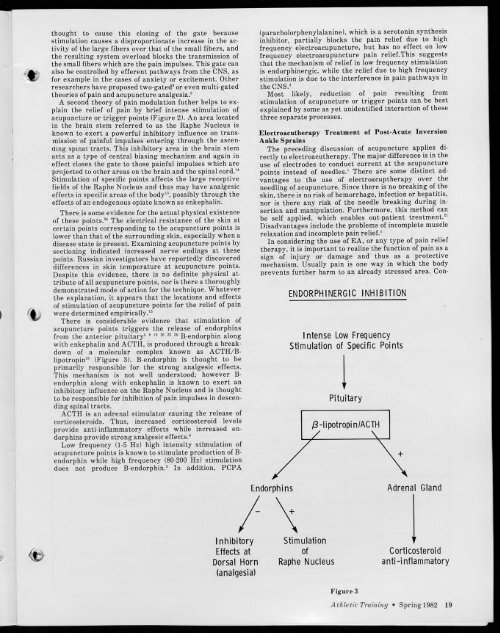Spring 1982 - Athletic Training History
Spring 1982 - Athletic Training History
Spring 1982 - Athletic Training History
You also want an ePaper? Increase the reach of your titles
YUMPU automatically turns print PDFs into web optimized ePapers that Google loves.
4thought to cause this closing of the gate becausestimulation causes a disproportionate increase in the activityof the large fibers over that of the small fibers, andthe resulting system overload blocks the transmission ofthe small fibers which are the pain impulses. This gate canalso be controlled by efferent pathways from the CNS, asfor example in the cases of anxiety or excitement. Otherresearchers have proposed two-gated9 or even multi-gatedtheories of pain and acupuncture analgesia. 2A second theory of pain modulation futher helps to explainthe relief of pain by brief intense stimulation ofacupuncture or trigger points (Figure 2). An area locatedin the brain stem referred to as the Raphe Nucleus isknown to exert a powerful inhibitory influence on transmissionof painful impulses entering through the ascendingspinal tracts. This inhibitory area in the brain stemacts as a type of central biasing mechanism and again ineffect closes the gate to those painful impulses which areprojected to other areas on the brain and the spinal cord. 14Stimulation of specific points affects the large receptivefields of the Raphe Nucleus and thus may have analgesiceffects in specific areas of the body 13 , possibly through theeffects of an endogenous opiate known as enkephalin.There is some evidence for the actual physical existenceof these points. 24 The electrical resistance of the skin atcertain points corresponding to the acupuncture points islower than that of the surrounding skin, especially when adisease state is present. Examining acupuncture points bysectioning indicated increased nerve endings at thesepoints. Russian investigators have reportedly discovereddifferences in skin temperature at acupuncture points.Despite this evidence, there is no definite physical attributeof all acupuncture points, nor is there a thoroughlydemonstrated mode of action for the technique. Whateverthe explanation, it appears that the locations and effectsof stimulation of acupuncture points for the relief of painwere determined empirically. 15There is considerable evidence that stimulation ofacupuncture points triggers the release of endorphinsfrom the anterior pituitary 5 8 19 20 22 25 B-endorphin alongwith enkephalin and ACTH, is produced through a breakdownof a molecular complex known as ACTH/Blipotropin18 (Figure 3). B-endorphin is thought to beprimarily responsible for the strong analgesic effects.This mechanism is not well understood; however B-endorphin along with enkephalin is known to exert aninhibitory influence on the Raphe Nucleus and is thoughtto be responsible for inhibition of pain impulses in descendingspinal tracts.ACTH is an adrenal stimulator causing the release ofcorticosteroids. Thus, increased corticosteroid levelsprovide anti-inflammatory effects while increased endorphinsprovide strong analgesic effects. 5Low frequency (1-5 Hz) high intensity stimulation ofacupuncture points is known to stimulate production of B-endorphin while high frequency (80-200 Hz) stimulationdoes not produce B-endorphin. 5 In addition, PCPA(paracholorphenylalanine), which is a serotonin synthesisinhibitor, partially blocks the pain relief due to highfrequency electroacupuncture, but has no effect on lowfrequency electroacupuncture pain relief.This suggeststhat the mechanism of relief in low frequency stimulationis endorphinergic, while the relief due to high frequencystimulation is due to the interference in pain pathways inthe CNS. 3Most likely, reduction of pain resulting fromstimulation of acupuncture or trigger points can be bestexplained by some as yet unidentified interaction of thesethree separate processes.Electroacutherapy Treatment of Post-Acute InversionAnkle SprainsThe preceding discussion of acupuncture applies directlyto electroacutherapy. The major difference is in theuse of electrodes to conduct current at the acupuncturepoints instead of needles. 1 There are some distinct advantagesto the use of electroacuptherapy over theneedling of acupuncture. Since there is no breaking of theskin, there is no risk of hemorrhage, infection or hepatitis,nor is there any risk of the needle breaking during insertionand manipulation. Furthermore, this method canbe self applied, which enables out-patient treatment. 21Disadvantages include the problems of incomplete musclerelaxation and incomplete pain relief. 1In considering the use of EA, or any type of pain relieftherapy, it is important to realize the function of pain as asign of injury or damage and thus as a protectivemechanism. Usually pain is one way in which the bodyprevents further harm to an already stressed area. Con-ENDORPHINERGIC INHIBITIONIntense Low FrequencyStimulation of Specific PointsPituitary/3-lipotropin/ACTH\Endorphins Adrenal GlandInhibitoryEffects atDorsal Horn(analgesia)StimulationofRaphe NucleusFigure 3Corticosteroidanti-inflammatory<strong>Athletic</strong> <strong>Training</strong> <strong>Spring</strong> <strong>1982</strong> 19


